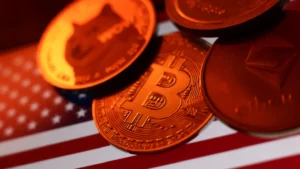Russia’s A7A5 Stablecoin Sidesteps Sanctions — and Sends Ripples Through Global Crypto Markets
How the Kremlin’s New Crypto Network Evaded Western Sanctions
At the center of the scheme is A7A5, a rouble-backed stablecoin used in the A7 cross-border payment system—a Russia-sponsored alternative to SWIFT.According to a Financial Times investigation, A7A5’s administrators “destroyed” 80 % of outstanding tokens tied to sanctioned wallets, then instantly recreated identical amounts in new accounts, effectively scrubbing their history.
The new wallet—active mainly during Moscow trading hours—has since processed over $6.1 billion in transactions.
This maneuver exposes the challenge regulators face in tracking blockchain-based sanctions evasion. It also underlines Moscow’s growing push to bypass dollar-dominated payment rails.
Why It Matters
- Geopolitical finance realignment: A7A5 has been officially authorized as a “digital financial asset” by Russia’s central bank, backed 1-to-1 with roubles via Promsvyazbank—a sanctioned defense lender.
- Global expansion: A7 claims to have handled $86 billion in ten months, with operations stretching from Eurasia to Africa.
- Western enforcement limits: Token burn-and-reissue techniques make sanctions nearly unenforceable without real-time blockchain monitoring.
- Regulatory fallout: The EU is preparing to ban transactions in A7A5 entirely; the U.S. is expected to tighten oversight on stablecoins traded via Tron and Ethereum networks.
Market Impact
- Crypto exchanges: Expect increased scrutiny of offshore venues operating from “friendly” jurisdictions such as Kyrgyzstan or the UAE.
- Stablecoin sentiment: Regulatory pressure could temporarily weaken USDT and USDC liquidity in Europe, but may also boost compliance-driven options like PYUSD.
- BTC & ETH: Historically rally on sanctions-driven capital flight; BTC has gained during every major Russia-related financial tightening since 2022.
- U.S. defense & cybersecurity names: Firms like PLTR, CRWD, and FTNT could benefit from demand for real-time blockchain surveillance and compliance systems.
Trading Implications
Day Trading:
- Watch COIN, RIOT, MARA: Look for intraday volume spikes tied to sanction-related headlines. Volatility tends to cluster around 9:30 – 11 a.m. ET.
Swing Trading:
- Long bias: NVDA, AMD, PLTR—beneficiaries of AI-driven compliance and crypto analytics demand.
- Short bias: Offshore exchanges and altcoins on Tron; potential U.S./EU sanctions could pressure TRX and low-cap privacy tokens.
- Macro hedge: Long gold (XAU/USD) or GLD ETF—historically rises during financial-sanctions cycles and blockchain capital shifts.
Bottom Line
The A7A5 network proves that digital finance can mutate faster than regulators can adapt.
For traders, the playbook is clear: **fade weak, over-hyped altcoins; favor compliant U.S. crypto equities; and watch BTC and ETH for safe-haven rotation** when sanctions headlines break.
This story reinforces a broader macro theme—**geopolitical risk is now a trading signal, not just a headline.**

